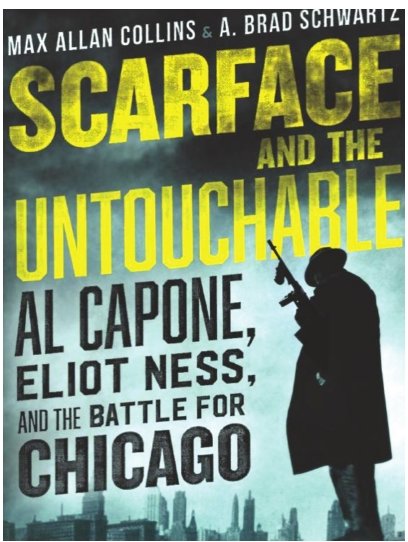
Author A. Brad Schwartz traveled to more than a dozen states, fired a Thompson submachine gun, held one of the weapons used in the legendary Saint Valentines Massacre in his hand and read boxes full of court and police records, while researching the lives of two Prohibition-era personalities.
Schwartz is the co-author with the novelist Max Allan Collins of a new book: “Scarface and the Untouchable: Al Capone, Eliot Ness and the Battle for Chicago.” In the ‘20s Al Capone controlled mob activities in Chicago, and Eliot Ness was the lawman who tried to bring him to justice. Schwartz, who grew up in East Lansing, previously wrote “Broadcast Hysteria: Orson Welles’ War of the Worlds.”
How Schwartz teamed up with Collins, who is one of the mystery genres most honored writers, is a story unto itself. Schwartz, who read Collins’ books voraciously growing up, traveled to Chicago and Des Moines to meet him at book signings and a play performance.
“We had all these shared interests and became good friends,” Schwartz said. One of their shared interests was “Dick Tracy,” whose story was patterned after Eliot Ness. Collins had written several mysteries based on life of the crime-solving FBI agent Ness, and was a writer of the newspaper cartoon “Dick Tracy.”
But before a newly minted University of Michigan graduate could join Collins in writing, he had to prove himself as a writer and researcher, which he did with his book on the famous Welles’ Halloween radio broadcast that had Martians invading Earth.
Schwartz talked to City Pulse while on the Chicago River. He said his back was to the office building where Frank Nitti, a Capone lieutenant, had survived an attempt on his life.
“Every day in Chicago is gangster day,” he said.
Schwartz said one of the hardest things to do in writing the book was “to forget everything we thought we knew about the two men.”
“We had to pull as much as possible from original sources, otherwise the stories would’ve continued to be shrouded in myth and lost in legend,” he said.
Schwartz traveled extensively to seek out original documentation by pulling old case files and indictments. He also spent time in Coudersport, Pennsylvania, where Ness spent the last years of his life writing an autobiography, which was disparaged at the time.
Schwartz said, “It turned out the autobiography was quite accurate.”
“While researching we could take nothing we read at face value,” he said.
However, the long-disputed story that Capone spent several summers in the Lansing area holed up at Round Lake is one that rings true for Schwartz.
“I wouldn’t dispute it,” he said.
References to Capone’s time at Round Lake unfortunately take up only a few paragraphs.
Schwartz found himself firing a Thompson submachine gun in order to prove or disprove descriptions of what it was like to fire the weapon. The weapon was used at the Saint Valentine’s Day Massacre, which is widely thought to have been set in motion by Capone.
Descriptions of how the weapon performed varied widely, but he found the weapon had very little kick. However, because the bolt works so fast it pushes the gun up — something you don’t expect.
“The agent told me to empty the clip, and I found myself shooting at the ceiling,” Schwartz said.
The weapon, which became the signature weapon for warring gangs in Chicago, is not precise, but it is devastating.
In one scene in the book, more than 1,000 bullets were fired in an attempt to kill Capone.
Schwartz said, “Capone was one criminal who sought publicity and attention.
He also had that identifiable look and came around at the right time for mass media.”
The authors describe in the book how after one particular hit, Capone called a press conference.
“Every Halloween gangster costume looks like Al Capone and he was the first to, in essence, confess openly to criminal activities,” the author said.
The 599-page book is backed up by impressive sourcing and footnotes.
“Once we got into working on the book, it was a partnership and we went back and forth until we were both satisfied. I deferred on narrative and Collins deferred to me on history. It was complementing not competitive,” Schwartz said.
“The result reads like a third voice,” he said.
The book generally alternates chapters between Capone and Ness, and it is in chronological order, which makes the lives of the two easy to follow.
Capone is often shown in paradoxical roles with wanting to be feared by other gangsters and loved by the populace.
Stories abound of him handing out $100 bills including newspaper stories about him in Lansing doing just that.
“It’s this paradox that makes him popular in popular culture,” Schwartz said.
Readers will enjoy this dual biography, which reads like a popular novel, and will learn that Capone could be a cold-blooded killer.
Ness is portrayed as the dedicated lawman who built a case against Capone for bootlegging that never went to court.
And about that famous quote from Capone about going further with a gun and a smile than with a smile alone — he never said it, but maybe Robert De Niro did.
Support City Pulse - Donate Today!
Comments
No comments on this item Please log in to comment by clicking here